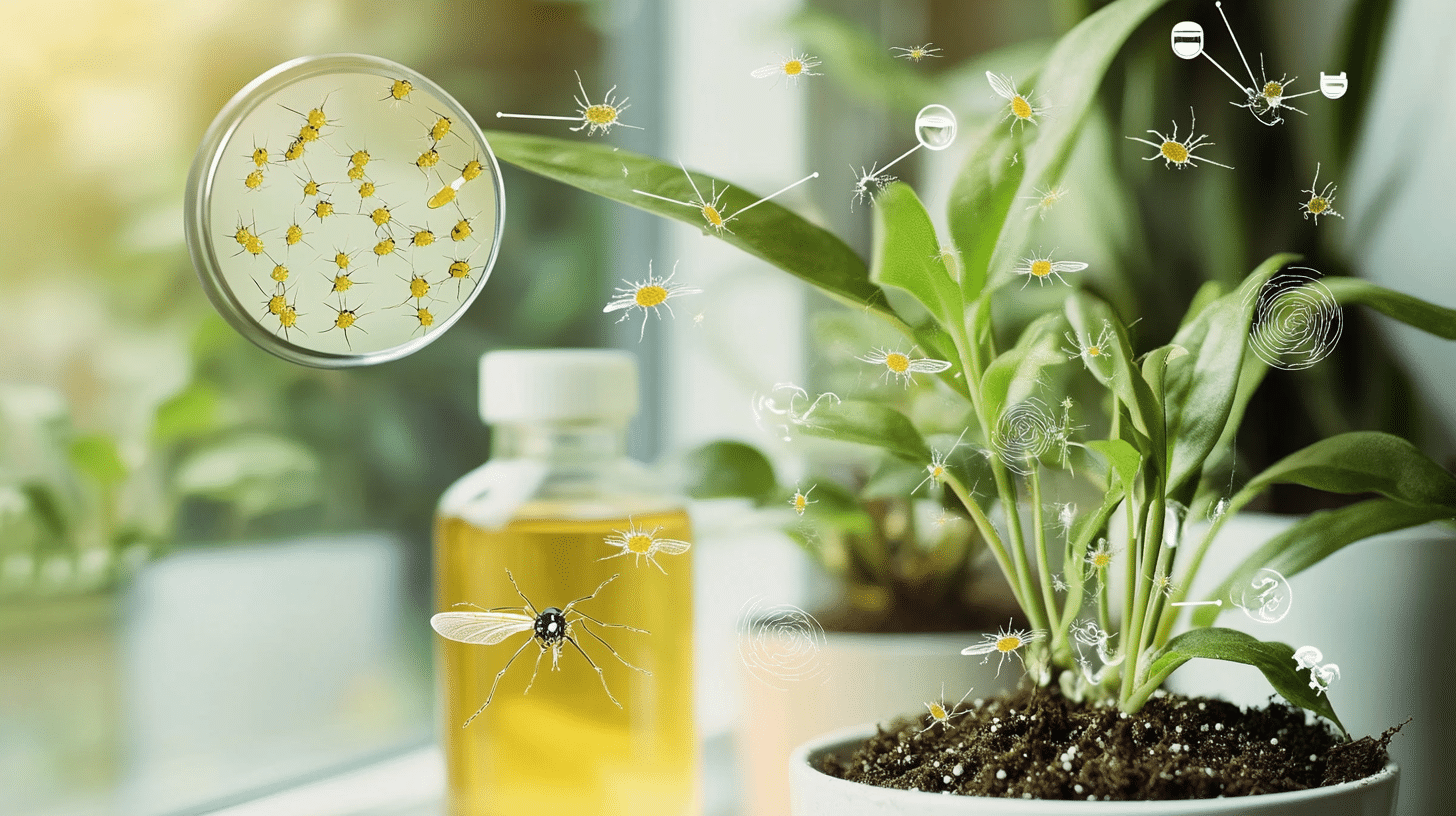How to Prevent and Remove Fungus Gnats
If you’ve ever noticed small, dark flies buzzing around your houseplants, you may be dealing with a fungus gnat infestation.
These tiny pests can quickly multiply, causing damage to your plants and becoming a nuisance in your home.
Fungus gnats thrive in moist, organic-rich soil, making overwatered houseplants the perfect breeding ground.
In this comprehensive guide, we’ll examine fungus gnats’ life cycle, the signs of an infestation, and the most effective methods of eliminating them.
We’ll also discuss preventive measures you can take to keep your plants healthy and gnat-free. By the end of this article, you’ll be equipped with the knowledge and tools needed to tackle fungus gnat problems and maintain a thriving indoor garden.
Understanding Fungus Gnats
What Are Fungus Gnats?
Fungus gnats are small, dark-colored flying insects commonly found buzzing around houseplants. Adult gnats have slender bodies, long legs, and transparent wings.
They are weak fliers and often appear in erratic, zigzag patterns near plants or windows.
Fungus gnats have four life stages: eggs, larvae, pupae, and adults. The tiny eggs are laid in moist soil and hatch into white, worm-like larvae with shiny black heads.
The larvae feed on fungi, algae, and plant roots before pupating and emerging as adult gnats.
Why Do Fungus Gnats Appear?
Fungus gnats are attracted to damp, organic-rich soil—conditions often found in overwatered houseplants. The moist environment is ideal for larvae development and promotes fungal growth, making it a food source for the gnats.
Other factors contributing to infestations include poor drainage, decaying plant matter, and lack of air circulation. Fungus gnats can hitchhike into your home on new plants or contaminated potting soil.
Identifying a Fungus Gnat Infestation
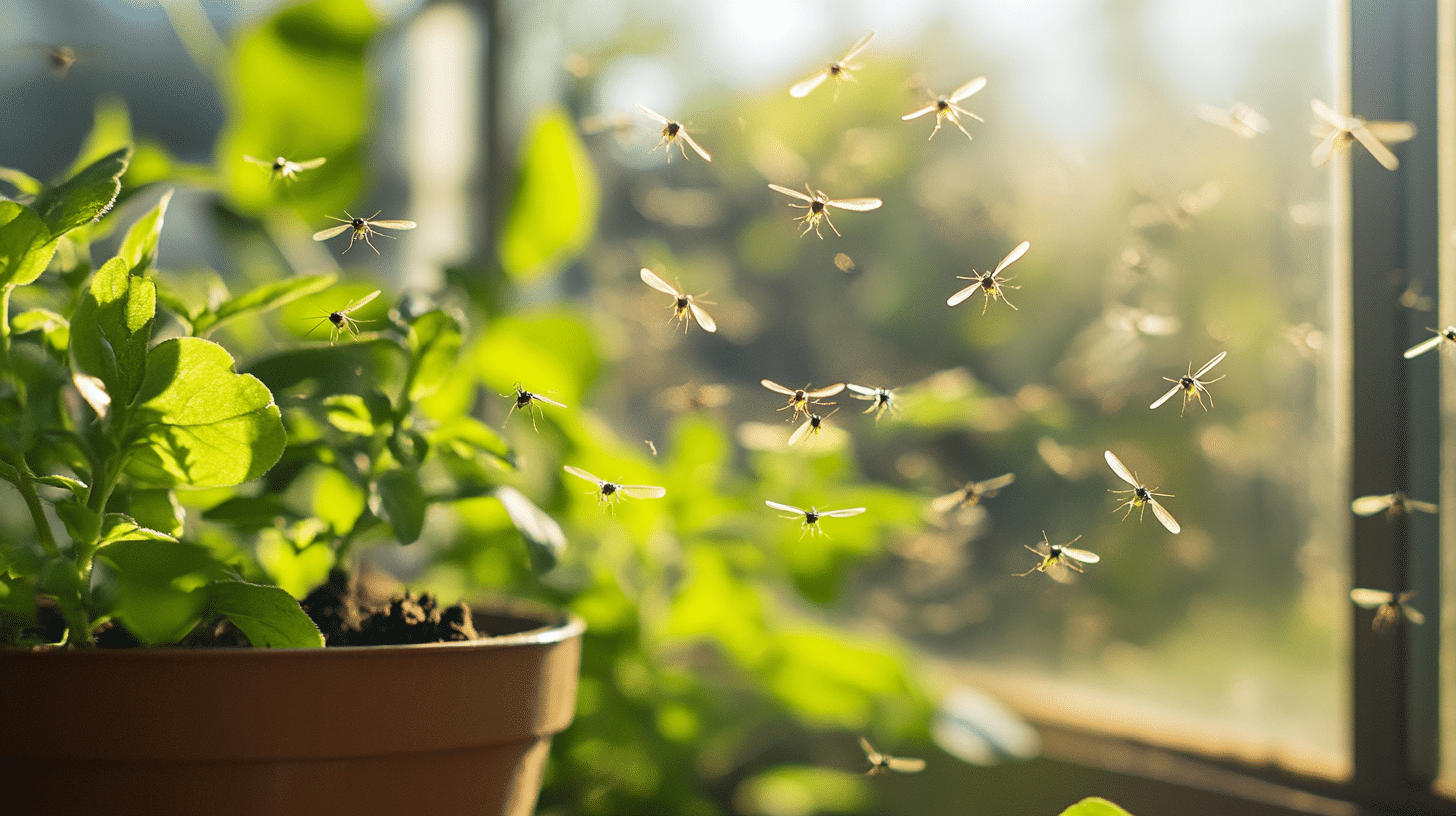
Signs to Look For
One of the most obvious signs of a fungus gnat infestation is seeing adult gnats flying around your plants or near windows. You may also notice them resting on plant leaves or soil surfaces.
To check for larvae, gently scrape back the top layer of soil. The small, whitish larvae will be visible wiggling in the soil, especially near the plant base.
Feeding fungus gnat larvae on plant roots can cause health issues for your plants. Symptoms may include stunted growth, yellowing leaves, wilting, and general weakness.
Differentiating from Other Pests
Fungus gnats are often confused with fruit flies. However, fruit flies are typically found near overripe fruits or garbage and have rounder, stouter bodies. Fungus gnats are more slender and are almost exclusively seen near plants or soil.
Other flying insects, such as whiteflies or aphids, can also be mistaken for fungus gnats. However, these pests generally infest plant foliage rather than the soil.
Effective Methods to Eliminate Fungus Gnats
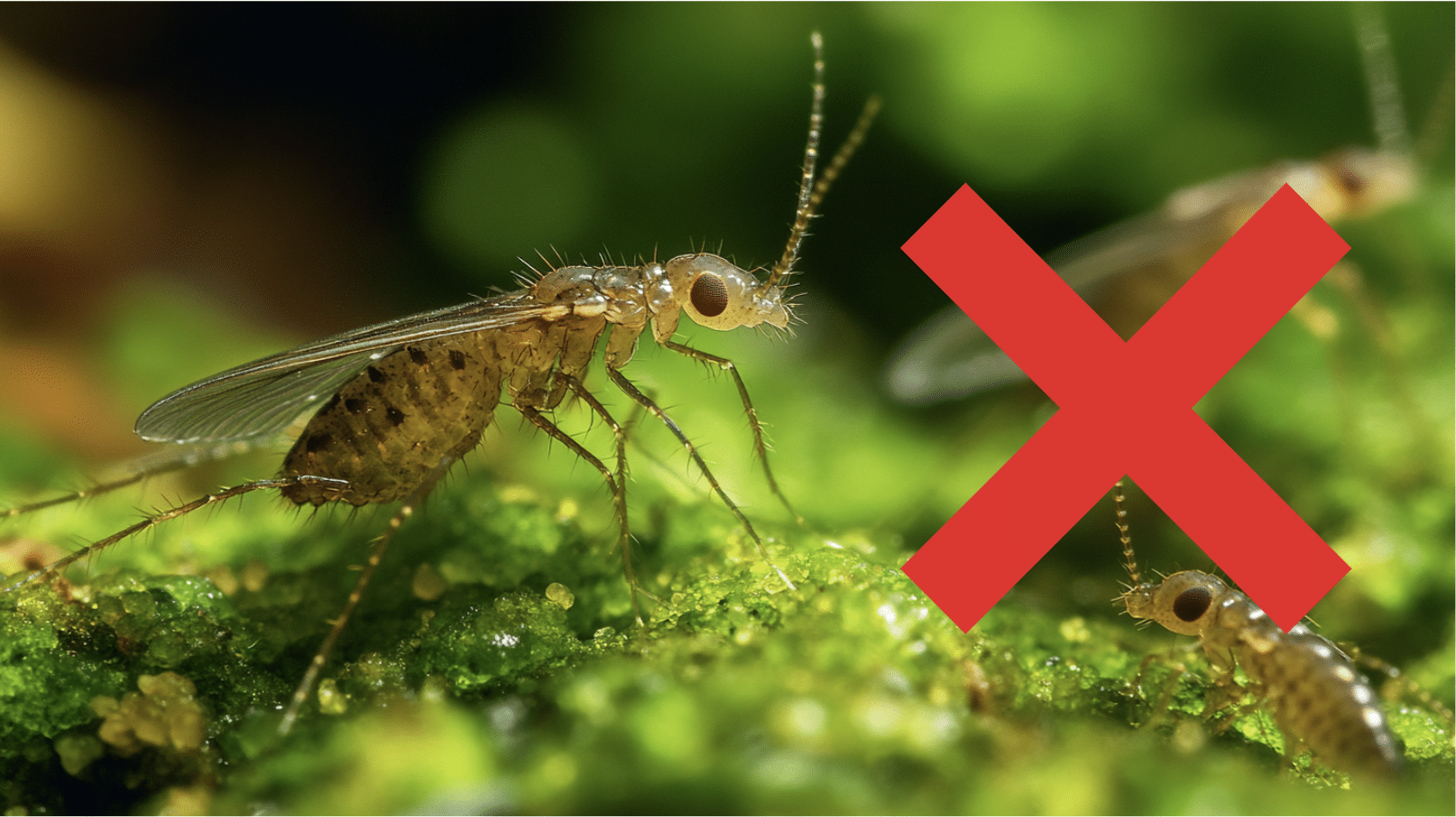
1. Hydrogen Peroxide Solution
How It Works
Hydrogen peroxide is an effective, fast-acting treatment for fungus gnat larvae. The solution kills larvae on contact by oxidizing their outer cells, effectively drowning them.
Mixing Instructions
To safely use hydrogen peroxide, mix one part of 3% hydrogen peroxide with four parts water. This dilution ensures the solution is strong enough to kill larvae but gentle enough not to harm plants.
Application Steps
Water your infested plants with hydrogen peroxide and saturate the soil until it drains from the bottom. Repeat this treatment once a week for three weeks to effectively eliminate larvae.
Safety Precautions
While the diluted hydrogen peroxide solution is generally safe for plants, testing it on a small area first is best. Some sensitive plants may react negatively. Always follow the mixing ratios carefully.
2. Sticky Traps
Purpose: Yellow sticky traps are an excellent way to capture adult fungus gnats, disrupting their life cycle and preventing further egg-laying. The bright color attracts gnats, and the sticky surface traps them.
Types of Traps: You can purchase ready-made yellow sticky cards or create DIY traps using yellow paper coated with a sticky substance like petroleum jelly or tree sap.
Placement Tips: Cut traps into smaller squares and place them directly on the soil surface near the plant base. You can also stick them onto small skewers or sticks for better visibility. Place traps in all affected pots.
Monitoring Infestation Levels: Sticky traps help gauge the severity of the infestation. A high number of trapped gnats indicates a more serious problem. Monitor the traps regularly and replace them when they become covered with gnats.
3. Natural Remedies
- Cinnamon: Cinnamon is a natural fungicide that inhibits fungal growth in the soil, helping to control fungus gnat populations. Sprinkle a layer of ground cinnamon on the soil surface and repeat every few weeks.
- Chamomile Tea: Chamomile tea contains antifungal properties that suppress fungal growth, making the soil less attractive to fungus gnats. Brew a strong chamomile tea, let it cool, and use it to water your plants.
- Diatomaceous Earth: Diatomaceous earth (DE) is a fine, abrasive powder that can desiccate and kill fungus gnat larvae. Sprinkle a thin layer of food-grade DE on the soil surface, being careful not to inhale the dust. Reapply after each watering.
- Neem Oil: Neem oil is a natural insecticide that can disrupt the life cycle of fungus gnats. Mix a few drops of neem oil with water and a mild soap, then spray the solution onto the soil surface. Repeat every few days.
- Apple Cider Vinegar Traps: Fill a small bowl with equal water and apple cider vinegar, then add a few drops of dish soap. Place the bowl near infested plants. Adult gnats will be attracted to the vinegar and drown in the solution.
4. Biological Controls
Beneficial nematodes are tiny, parasitic roundworms that seek out and kill fungus gnat larvae in the soil.
Mix the nematodes with water according to the package instructions, then drench the soil. Nematodes are safe for plants and pets.
5. Environmental Adjustments
- Drying Out Soil: Allowing the soil to dry out between waterings can significantly reduce fungus gnat populations. Larvae require consistent moisture to survive, so letting the top few inches of soil dry will make the environment less hospitable.
- Improving Drainage: Ensure all your pots have proper drainage holes to prevent water from accumulating in the soil. To improve aeration and drainage, you can amend potting mixes with perlite, vermiculite, or sand.
Preventing Future Fungus Gnat Infestations
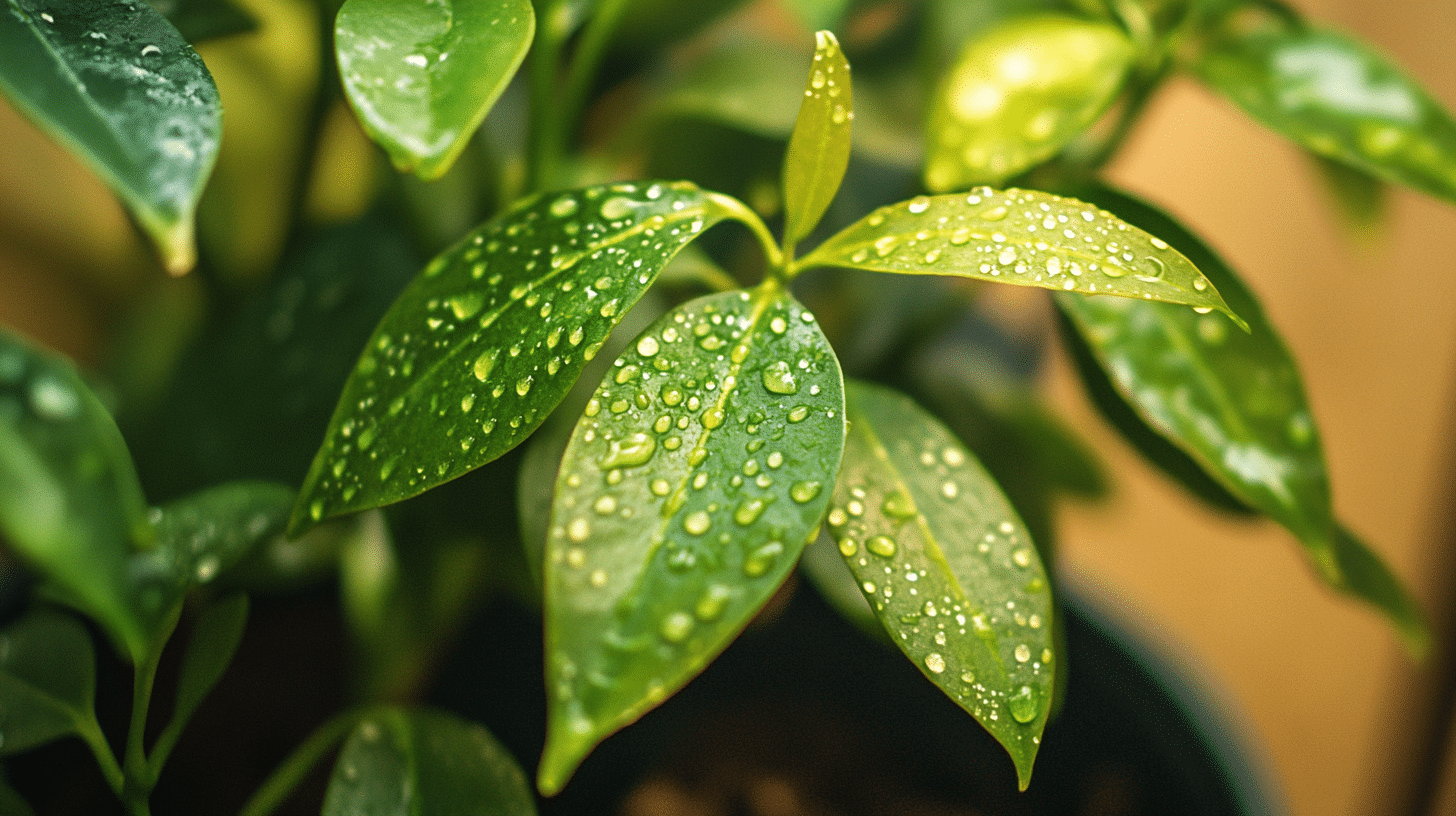
Importance of Avoiding Overwatering
Overwatering is the primary cause of fungus gnat infestations. Water your plants only when the top inch of soil feels dry. Before watering, stick your finger into the soil to check moisture levels.
A moisture meter can help you more accurately determine when your plants need water, preventing overwatering and reducing the risk of fungus gnat issues.
Soil Management
- Using Sterile Potting Mix: Always use sterile, well-draining potting mix when repotting plants or starting new ones. Avoid using garden soil or reusing old potting mix, as these may harbor fungus gnat eggs or larvae.
- Soil Covers: Adding a layer of sand, gravel, or decorative stones to the soil surface can deter fungus gnats from laying eggs. These covers also help regulate moisture levels and improve drainage.
Plant Quarantine Practices
Inspecting New Plants: Before bringing new plants into your home, thoroughly inspect them for signs of pests, including fungus gnats. Check the soil and foliage for any insects or larvae.
Isolating New Additions: Quarantine new plants for a week or two to prevent potential infestations from spreading. Keep them separate from your other houseplants and monitor closely for any signs of fungus gnats or other pests.
Maintaining Plant Health
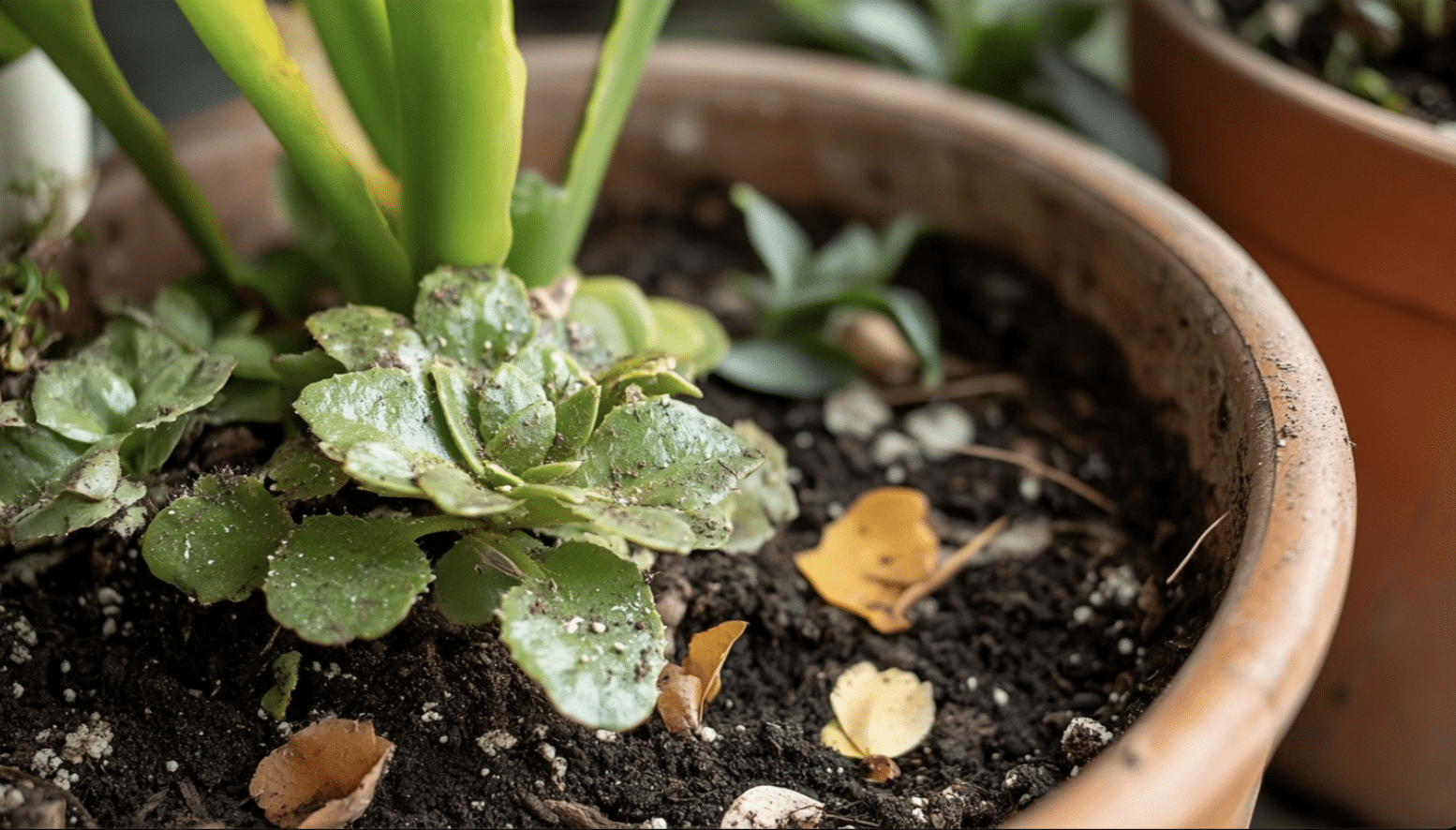
Regular Monitoring
Regularly inspect your plants for early signs of fungus gnat activity. Check the soil, leaves, and sticky traps for any indications of an infestation. Catching the problem early makes it easier to control.
Cleaning and Maintenance
Keep your plants clean and tidy. Promptly remove dead leaves, fallen flowers, and other plant debris from the soil surface. These decaying materials can attract fungus gnats and provide a breeding ground for larvae.
Understanding fungus gnats, identifying infestations, and implementing effective control methods can successfully eliminate these pesky insects from your houseplants.
Combining multiple strategies, such as hydrogen peroxide treatments, sticky traps, and natural remedies, can provide a comprehensive approach to managing fungus gnat populations.
Remember, prevention is key. Proper watering techniques, using a sterile potting mix, and quarantining new plants can significantly reduce the risk of future fungus gnat infestations.
Regular monitoring and a clean growing environment will also help keep your houseplants healthy and thriving.
Video Tutorial
For More Details, Check out This Detailed Video Tutorial by Plant Life with Ashley Anita.
Final Words
Fungus gnats can be a frustrating problem for houseplant enthusiasts, but with the right knowledge and tools, you can effectively eliminate them and prevent future infestations.
By understanding their life cycle, identifying signs of their presence, and implementing a combination of control methods—such as hydrogen peroxide treatments, sticky traps, natural remedies, and environmental adjustments—you can create an inhospitable environment for these pests.
Remember, the key to long-term success is prevention. Proper watering techniques, soil management, plant quarantine practices, and regular monitoring will help you maintain a healthy growing environment for your plants while minimizing the risk of fungus gnat issues.
With patience and persistence, you can keep your houseplants thriving and gnat-free.
Frequently Asked Questions (FAQs)
Are Fungus Gnats Harmful to My Plants or Me?
Larvae can damage roots; adults are harmless to humans but can be annoying.
How Long Does It Take to Get Rid of Fungus Gnats?
With consistent treatment, infestations can be controlled within a few weeks.
Can I Use Household Vinegar Instead of Apple Cider Vinegar for Traps?
Yes, but apple cider vinegar is more effective due to its sweetness.

